The Japanese woman, or Japanese diet, was developed by nutritionists at YaELO Clinic (Yaeks). The principle of the technology is based on the use of low-calorie food for 7-14 days. Before embarking on a strict diet, experts recommend preparing mentally - the weight loss system requires strict adherence to all the rules of the method. This system of getting rid of excess weight is characterized by a long exit: it lasts for 4 weeks. Despite high activity, the diet can harm the body, especially if there are contraindications.

Principle of weight loss
The Japanese diet is designed for 7, 14 or 13 days. Proper weight loss is achieved by using foods that are high in protein. Foods high in carbohydrates and fats are excluded from the diet. The technology is considered "salt-free". The initial stages of weight loss are accompanied by normal metabolic processes in the body, elimination of toxins. The fat burning process begins in 2-3 days.
It is impossible to deviate from the government - the diet is strictly prescribed. Due to the lack of sufficient carbohydrates in the dishes, the duration of the diet should not exceed 14 days. The appearance of side effects requires immediate dietary treatment and is the reason for contacting a medical institution. Vitamins and minerals are encouraged for weight loss, the complexity is chosen individually. The risk of dieting can take up to a month.
Nutritional rules

Dishes from permitted foods can quickly fill you up. This is due to their presence in the main component "protein". Carbohydrates and fats enter the body in small amounts. Fiber is found in fresh vegetables and fruits and their use is not limited. Soluble dietary fiber promotes the normal functioning of the digestive system. Antioxidants involved in metabolismfound in green tea and natural coffee.
A specially selected menu for each day provides the body with the necessary nutrients.
The drinking process should be carefully monitored: at least 1, 5 liters of fluid must be drunk per day. The presence of salt, sugar and hot spices in dishes is unacceptable. Limited number of meals: no more than 3 times a day. You can not have a snack.
Experts recommend giving up sweets and junk food in advance - this will help to avoid failure. Dose reduction is recommended.
Allowed and prohibited products
The list of products allowed for consumption is strictly limited. For 14 days, a daily menu can include:
- meat and poultry products;
- fish;
- bread;
- vegetables;
- fruit;
- natural freshly squeezed juices;
- dairy products;
- tea and still mineral water.
Vegetables, fruits and vegetables you can eat:
- zucchini;
- carrot;
- eggplant;
- Cabbage;
- apples;
- pineapple;
- pears;
- kiwi;
- grapefruit;
- citrus fruits (lemons, oranges).
Bread and debris should be rye. Lean meat (lean beef, chicken, turkey) and fish (halibut, blue whiting, cod) are heat treated. Eggs are allowed, but in small quantities. Drinks (green tea, natural weak coffee, boiled water) should not contain sweeteners. You can drink tomato juice and low-fat (1%) kefir. Olive oil is included in the diet.
Prohibited foods must be completely excluded from the menu. These include:
- fatty meats and fish;
- vegetable oils;
- salt and sugar;
- fast food;
- wheat products;
- smoked and boiled sausages;
- semi-finished products and canned food;
- sweets and pastries;
- foods containing starch (vegetables, cereals);
- alcohol and tobacco products;
- sauces, marinades.
Vegetables and fruits:
- Cherries;
- cherries;
- Grenade;
- persimmon;
- mandarins;
- mango;
- figs;
- the age of love;
- grapes.
Dried fruits:
- prunes;
- raisins;
- dried apricots;
- dates.
The Japanese rarely eat dairy products, as they are often lactose intolerant, so they are not included in the diet.
It is necessary to exclude potato chips, sweet and salty popcorn from the diet. Semolina, barley and millet are not used to cook foods that promote fat burning.
Prohibited flour products:
- pancakes;
- buns;
- vareniki;
- spaghetti (noodles);
- pancakes;
- pasta;
- wheat bread;
- muffins.

Confectionery (sweets, cookies, pastries, rolls, cakes, marshmallows, halva, confectionery, jam) is strictly prohibited. Spices (spices, mayonnaise, ketchup) are not added to the dishes. All dairy products (sour cream, cheese, fermented baked milk, skim milk, cream) are prohibited.
Meat and sausages:
- pork;
- mutton;
- ham;
- boiled pork;
- Salo;
- smoked sausages;
- uncooked smoked, boiled, dry sausages.
Dried, smoked and hard fish should be removed from the diet immediately. Poultry meat is only consumed in cooked form. Do not use chocolate, ghee and butter. Alcoholic beverages and tobacco products are excluded 2-3 weeks before weight loss. A very carbonated sweet drink (lemonade, kvass) is replaced by still mineral water.
Dried fruit meats, jellies are not included in the drinking diet. It is also necessary to avoid cherries, apples, pomegranates, grapes and orange juice. Nectars are made from pineapple and tomatoes, they are drunk in small quantities.
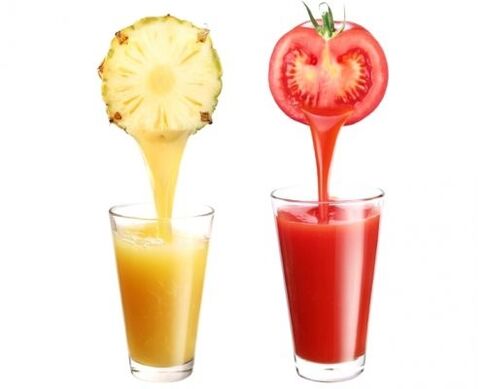
Types of Japanese diet
There are 3 types of Japanese diet. They vary in the number of days:
- 7 days;
- 13 days;
- 14 days.
The diet needs to be fed regardless of the type of technology.
Diet 14 days
The salt-free slimming system is designed for 2 weeks. During this period, fat cells are gradually released and burned. For the first 3 days, the body is cleansed. During this period, experts recommend drinking plenty of fluids: boiled water and green tea speed up the leaching of the remaining toxins. The diet can usually be divided into 2 steps, each lasting 7 days. In the first stage, kefir is included in the menu. Dishes are steamed, fried and fried are ignored.
Diet for 7 days
The sweetest technology is designed in a week. During this period, you can not lose more than 3-4 pounds. The menu is strict, the products are strictly limited and can not be replaced. During the weight period, restructuring takes place where the body gets used to the new diet and therefore experts consider this system to be the least effective. The menu can include traditional Japanese cuisine prepared with permitted ingredients. They cannot be added. For people who want to lose weight according to Japanese women, nutritionists recommend choosing a "light" option.
Diet for 13 days
The procedure of this type does not differ from the previous two. Dose does not exceed 200 g, liquid is consumed when thirsty. Dietary intake - at the same time for 13 days. It is mandatory to follow all the rules of detox nutrition. In less than 2 weeks there is a complete cleansing of the intestines, the process of burning fat happens gradually, because in problem areas the skin retains its elasticity. The energy consumed is replenished with protein foods.
Diet for the day
Slim dishes are adapted to European cuisine and do not contain exotic ingredients. The scheduled menu is designed for 7 days, on the 8th day it is repeated. It is allowed to change drinks: replace coffee with green tea, kefir - for tomato juice. The daily norm of the product, if necessary, is divided into 2 parts according to the number of days (with weekly weight loss).
Diet (for 14 days):
- chicken fillets - 1 kg;
- fish fillets - 2 kg;
- lean beef - 1 kg;
- biscuits or rye bread - 0, 5 kg;
- chicken eggs - 20 pcs. ;
- cabbage - 2 pcs. ;
- zucchini and / or eggplant - 1 kg;
- carrots - 2, 5-3 kg;
- fruit (unsweetened) - 1 kg;
- lemons (large) - 2 pcs. ;
- kefir (low fat) - 1 l;
- olive oil - (cold pressed) - 0, 5 l;
- tomato juice (homemade) - 1 liter;
- natural coffee (grain or powder) - 1 pack;
- green (large leaf) tea - 1 pack.
The speed of water use depends on the age and weight of the person.
The meal set is enough for three meals a day. Carbonated mineral water can be replaced by boiled water. The minimum volume of liquid per day is 1, 5 liters.
Detailed daily menu schedule (by day):
- For breakfast (8. 00) - a cup of weak natural coffee. Do not add cream, sugar, condensed milk. For lunch (13. 00) - finely chopped cabbage fried in its own juice by adding a small amount of olive oil, 2 hard-boiled eggs and 250 ml of tomato juice. For dinner (18. 00) - fish (200 g boneless fillets), steamed or boiled.
- Breakfast - coffee without milk and sugar, a slice of rye bread. Lunch - cabbage fried with olive oil and boiled (boiled) fish fillets (100 g). Dinner - boiled beef puree (100 g) and 250 ml of low-fat kefir.
- For breakfast - a cup of weak natural coffee and rye bread. For lunch - vegetable steak from eggplant or zucchini. For dinner - a salad of fresh cabbage, seasoned with oil. You can eat 2 eggs and 200 g of boiled lean beef (pulp).
- Breakfast - raw mashed potatoes, lemon juice. Lunch - boiled boneless fish fillets (200 g), 250 ml of tomato juice. Dinner - unlimited fruit.
- For breakfast - raw mashed carrots, lemon juice. For lunch - boiled boneless fish fillets (200 g), a glass of tomato juice. For dinner - fruit in any quantity.
- Breakfast - coffee or green tea without sugar. Lunch - 0, 50 boiled chicken (skinless breasts or thighs), fresh vegetable salad (carrots and cabbage) with a little oil. Dinner - boiled chicken eggs (2 pcs. ), Salad of freshly grated carrots with butter.
- For breakfast - green tea without sugar. For lunch - boiled or boiled beef. For dinner - any dish (excluding dinner for 3 nights).
The menu can be displayed clearly. Experts recommend placing a sheet with a drawing in a prominent place.
The right way out of the diet
Some form of diet must be followed 2-4 weeks after the diet. During weight loss, the body becomes accustomed to low-dose, low-calorie foods. Avoiding diet is necessary to maintain a normal weight and optimal gastrointestinal function. It is recommended to return to a regular diet gradually: foods rich in carbohydrates are added only every day. The duration of the publication is at least 14 days.
Meals should be fragile, do not increase the weight of the dose. A diet should be characterized by foods that are low in calories and improve the energy stored in weight loss. It is not recommended to reduce the amount of protein in the diet (chicken eggs, poultry and fish). In the menu, fats and carbohydrates are gradually introduced. Salt and sugar can be added in small portions. Drink should be enough, consume no more than 2 liters per day.
While eating a diet, breakfast cereals are allowed. Oatmeal, buckwheat and rice are boiled in water. Vegetables and fruits are eaten raw in any quantity. It is best to give sweet and sour apple varieties. Snacks are served between main meals: a glass of kefir or rice cakes. Rye bread is replaced by whole grain or unleavened bread.
Pasta and sweets, baked goods and snacks are not included in the diet.
Food costs
Products approved for use in weight loss are mid-priced.
pros and cons
Japanese weight loss technology has many advantages and disadvantages. The benefits include:
- efficiency;
- supply;
- cleansing at the same time as losing weight;
- detailed menu;
- Three meals a day;
- increased muscle tension.
Efficiency is due to rapid fat burning, the result will appear after 7 days. The products are accessible to everyone and can be bought in any store. There is no need to calculate calories in advance, the menu is clearly written. Food is taken 3 times a day, the diet is healthy, so the feeling of hunger rarely occurs. Cleansing the body helps to normalize the metabolic process. Due to the high protein content in food, muscle building is strengthened.
The disadvantages are:
- dietary imbalances;
- lack of vitamins and minerals;
- lack of a good breakfast;
- the need to follow the rules of discontinuation of the diet;
- short-term weight loss;
- contraindications.
Dietary imbalances and inconsistencies in fat, protein and carbohydrate levels increase the risk of side effects. Decreased natural defense response, worsening of the condition of nails and hair is manifested in light of the lack of vitamins in the body. The right way out of the diet prevents the development of stressful conditions that can lead to rapid weight gain.
Contraindications and damage

The diet is only suitable for healthy people. Before you lose weight, you need to have an examination and consult a nutritionist. Contraindications include:
- pregnancy at any time;
- breastfeeding;
- gastric and duodenal ulcers;
- perforated lesions of the gastrointestinal tract;
- renal and hepatic pathology, e. g. mt bilun;
- anemia;
- gallbladder disease;
- infectious diseases;
- cardiovascular pathology;
- hypovitaminosis;
- diabetes;
- high blood pressure;
- exacerbation of chronic diseases;
- arthritis.
The diet is not suitable for the elderly and adolescents. Failure to follow the general rules of technology increases the risk of side effects. In the early days, nausea and bowel movements (constipation or diarrhea) may occur. Indigestion is accompanied by excessive flatulence or shingles. Bad breath, heartburn and shortness of breath occur. Headache occurs due to complete refusal of sugar.
Nervousness and sleep disorders develop for the same reason. Due to the lack of fat, a bitter taste appears in the mouth. The appearance may worsen: the skin becomes pale and dry. Malnutrition leads to joint pain.
Food recipes
Diet is added to the menu upon departure. You can diversify your diet with salads, first and second courses. Homemade desserts with low sugar content improve brain function and can be consumed after 14-15 days.
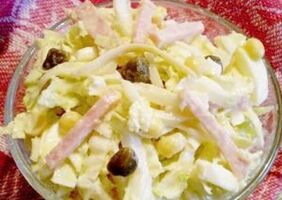
"Hope" food salad contains the following ingredients:
- potatoes - (2 pcs. );
- milk sausages - (2 pcs. );
- chicken breast - (250 g);
- pickled cucumber - (1 pc. );
- green;
- salt;
- olive oil - (1 tablespoon).
Cut boiled potatoes, boiled chicken and sausages into cubes. Put the mass in a deep bowl and season with salt. Add the cucumber to the strips and finely chop the greens there.
Season the salad with olive oil (first squeezed).
Kale:
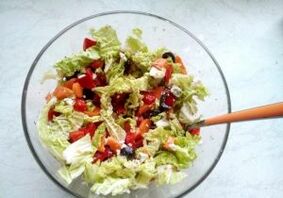
- Peking cabbage - (250 g);
- fresh cucumbers and tomatoes - (250 g);
- chili pepper - (1 pc. );
- hard cheese - (150 g);
- salt;
- olives (1/2 can);
- olive oil.
Tear the Chinese cabbage leaves into small pieces by hand. Cucumbers and tomatoes are cut into large pieces. Chop the chili (half a vegetable) in a mixer. Mix all the ingredients together, salt and season with oil. Garnish the salad with grated cheese and olives on top.
The first courses are consumed at lunch. For ease of digestion, soups are artificially mashed. Spinach and celery soup:
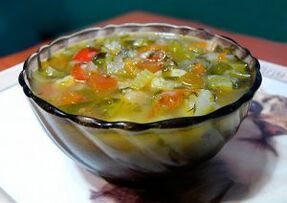
- lemon - (1 pc. );
- tomatoes - (2 pcs. );
- spinach - (200 g);
- celery - (stem, 2 pcs. );
- green;
- vegetable broth - (1, 5 l);
- salt;
- olive oil - (1 tbsp. l. ).
Pour olive oil into a preheated pan. Finely chop the celery stalk and fry in oil. In a special saucepan, bring the broth to a boil, put the chopped spinach in it and simmer for 5-7 minutes. Remove the skin from the tomatoes and grind in a blender. Add tomato puree to spinach. Boil the salt, add the frying to it. Cook for 15-20 minutes. Add a little lemon juice and chopped herbs to the finished soup.
Mushroom cream soup:
- champagne - (8 pcs. );
- potatoes - (2 pcs. );
- zucchini - (300 g);
- carrots - (1 pc. );
- onion - (1 pc. );
- weak meat broth - (1 l);
- flour - (1 tbsp. l. );
- olive oil - (2 tbsp. l. );
- cream - (1 tbsp. l. ).
Cut boiled vegetables into small cubes and cut into blenders. Bring to the boil. Fry the flour until golden brown, add the broth, add the vegetable puree. Boil the soup over low heat until it thickens, add salt, add cream and garnish with herbs. The first dish is served with rye bread crowns.
Beef with vegetables:
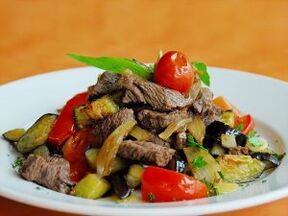
- beef - (500 g);
- olive oil - (3 tbsp. l. );
- potatoes - (200 g);
- carrots - (1 pc. );
- paprika - (1 pc. );
- onion - (1 pc. ).
Spread the onion, pepper and grated carrots in half rings in olive oil. Boil the beef until it is half cooked, cool and cut into small pieces. Put the meat on fried vegetables, salt. Put the cut potatoes in strips on top. Salt again. Pour broth into the vegetables. Cook the dish over low heat for 25-30 minutes.
Indian manti is a diet, its preparation takes place in 2 stages. Ingredients for the dough:
- flour - (1, 5 cups);
- hot water - (1 glass);
- salt.
Dissolve the salt in warm water. Pour flour on the work table, make it depressing. Pour salted water into portions and knead the elastic dough gradually. Cover with a towel and let stand for 15-20 minutes.
Although the dough "fits", you need to prepare the dressing. Necessary components:
- champagne - (6-8 pcs. );
- carrots - (1 pc. );
- green onions - (4-5 feathers);
- zucchini - (400 g);
- olive oil - (2 tbsp. l. );
- tomato paste - (2 tbsp. l. );
- chicken fillets - (400 g).
Cut the champignons, zucchini and carrots into small cubes. Boil the chicken fillet and cut into strips. Fry onions in oil and tomato paste, gradually add carrots, zucchini, mushrooms and meat. Pour 150-200 ml of water into the frying pan and let the vegetables boil until tender.
Roll out the dough into thin strips and grease each with oil. Cut the strips into squares (10x10 cm), which are stacked on top of each other. The dough is steamed in a press or diced machine for 15-20 minutes. The "columns" of the dough are placed on a plate, poured over with vegetable sauce and sprinkled with herbs.
Results and reviews
In 2 weeks you can lose 8-9 kg. Most women and men who have lost weight using this technology speak positively about it.
First comment, woman, 36 years old
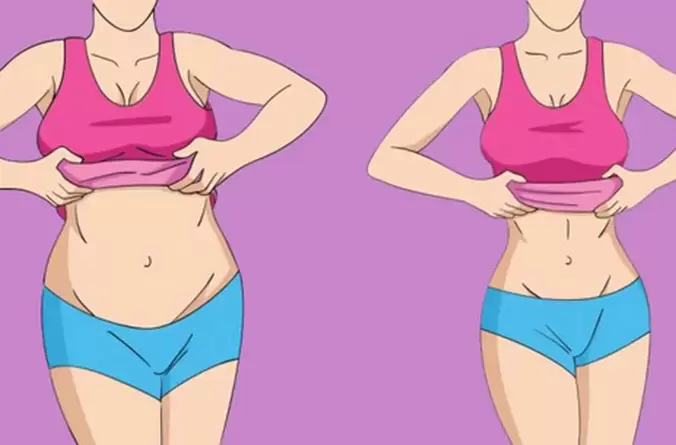
I started to recover during my teenage years, I tried many diets - they did not help. I went to a dietitian, went for a medical examination, ate separately, constantly calculated calories, arranged fasting days and could only lose 2 kilos in 5 months. My friend recommended the Japanese fat burning system, I did not manage to lose 7 kg in 2 weeks. I decided to give it a try.
A medical examination revealed no contraindications. The dietitian gave detailed recommendations regarding the diet. The system does not require large material investments. On the doctor's advice, she painted the menu in detail, fixed the sheet in the refrigerator. For the first 3 days, I almost fell through: the doses seemed small, the feeling of hunger was constantly there. On day 4 it was easier, I tried to chew food longer and drink more fluids.
The second stage of weight loss flew fast. I cooked in the machine: I remembered the ingredients of the dishes and their weight. The food began to seem satisfying, the hunger almost disappeared. There were no side effects, except short-term headache on day 3. The nutritionist explained that this was due to a lack of sugar. I stopped the diet for 20 days. I liked the food at the exit, so I completely gave up sweet, fatty, salty and smoked foods. I am pleased with the result: in 2 weeks I lost 10, 5 kg. In six months I will use this diet again.
Other comment, woman, 28
I learned about technology 2 years ago. At that time she weighed 107 kg, with an increase of 164, the number is important. There were health problems and I was not happy with my appearance. Her friends could not recommend a successful diet, so she decided to consult a specialist. The doctor recommended trying to lose weight using the Japanese weight loss system. The long menu was frightening at first, but the nutritionist reassured and explained the diet in detail.
In 7 days it took 5 kg. The dishes on the menu are good, I ate one serving. At first there was slight dizziness and little bowel dysfunction. The side effects went away on their own. She took food at the same time. The second stage of weight gain was easy: lightness, appearance and general well-being improved. Thanks to the diet, I quit smoking and quit alcohol altogether. 13 kg was lost during the release period. For 1, 5 years I have eaten right, I have swum and jogged, my previous weight has not paid off.
















































































